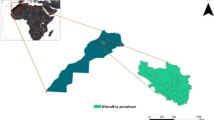Abstract
This work introduces the development and application of a multi-goal evaluation procedure for assessing sets of remedial options that have previously been found technically suitable for managing a certain contaminated site. The construction of this decision support tool, in the form of a balanced scorecard, has followed a multi-attribute conception of the contaminated sites problem, identifying the most critical aspects considered by all stakeholders involved in contaminated sites management decisions. The developed tool has been checked in its formulation and application against an export benchmark of an Austrian remediation project. The performed evaluation allowed to identify and suggest a remedial option that best fitted the expectations of all stakeholders involved in the project. Furthermore, through the accomplishment of a sensitivity analysis it has been demonstrated that the system is stable and robust in terms of the chosen elicitation schemes, and that the preferences of the different stakeholders are influencing factors on the final result. The results and conclusions of this work present the benefits of implementing the developed balanced scorecard as a tool for supporting decision making in contaminated sites remediation projects.






Similar content being viewed by others
References
AusAID (Australian Agency for International Development) (2003). AusGUIDElines-1. The logical framework approach. Commonwealth of Australia: AusAID.
Bezama, A. (2006). A knowledge-based system for contaminated sites management. Dissertation, University of Leoben, Austria.
Bezama, A., Navia, R., Novak, J., Staber, W., & Lorber, K. E. (2004). Novel approaches for the management and redevelopment of contaminated sites. Österreichische Abfall-und Wasserwirtschaft, 56, 11–12, 139–144.
BMLFUW (Austrian Federal Ministry of Agriculture and Forestry, Environment and Water Management) (2001). Federal waste management plan 2001. Vienna: Federal Ministry of Agriculture and Forestry, Environment and Water Management, Division III/3.
Bonano, E. J., Apostolakis, G. E., Salter, P. F., Ghassemi, A., & Jennings, S. (2000). Application of risk assessment and decision analysis to the evaluation, ranking and selection of environmental remediation alternatives. Journal of Hazardous Materials, 71, 35–57.
CSD (Commission of Sustainable Development) (2000). Indicators of sustainable development: Guidelines and methodologies. Final report of the CSD work programme on indicators on sustainable development. New York: United Nations, Division for Sustainable Development.
CSM (Contaminated Sites Management Working Group of Canada) (Ed.) (1997). Site remediation technologies: A reference manual. Quebec: Environment Canada, Hazardous Waste Branch.
Gholston, S. E., & Youngblood, A. D. (2004). Multiple objective decision making using estimated utility functions. In Proceedings of the 25th national conference of the American society for engineering management. Managing in a Dangerous World. Alexandria, Virginia (USA), October 20–23.
Hämäläinen, R. P. (Ed.) (2002). Value tree analysis. Report for the Multi Criteria Decision Analysis (MCDA) eLearning Site. Retrieved October 20, 2005, from Helsinki University of Technology, Systems Analysis Laboratory Web site: http://www.mcda.hut.fi.
Hamby, D. M. (1996). Sites remediation techniques supporting environmental restoration activities – A review. Science of the Total Environment, 191, 203–224.
Hirst, I. L. (1998). Risk assessment. A note on F-n curves, expected numbers of fatalities, and weighted indicators of risk. Journal of Hazardous Materials, 57, 169–175.
Jacobsen, H., & Kristoffersen, M. (2002). Case studies on waste management minimisation practices in Europe (Topic report 2/2002). Copenhagen: European Environmental Agency.
Kaplan, R. S., & Norton, D. P. (1996). The balanced scorecard – Translating strategy into action. Boston, MA: Harvard Business School Press.
Köbberling, V., & Peters, H. (2003). The effect of decision weights in bargaining problems. Journal of Economic Theory, 110, 154–175.
Madarász, T. (2005). Application and criteria of health risk assessment in contaminated land remediation. Dissertation, University of Miskolc, Hungary.
Martinsons, M., Davison, R., & Tse, D. (1999). The balanced scorecard: A foundation for the strategic management of information systems. Decision Support Systems, 25, 71–88.
Mooraj, S., Oyon, D., & Hostettler, D. (1999). The balanced scorecard: A necessary good or an unnecessary evil? European Management Journal, 17, 5, 481–491.
Novak, J. (2005). Entwicklung eines EDV-gestützten decision support systems für die nachnutzung von industriebrachflächen. Dissertation, University of Leoben, Austria.
OECD (Organisation for Economic Co-operation and Development) (1997). OECD Environmental performance reviews – A practical introduction (Report OCDE/GD(97)35). Paris: OECD Environment Policy Committee and Environmental Directorate.
Scholz, R. W., & Schnabel, U. (2006). Decision making under uncertainty in case of soil contamination. Journal of Environmental Management, 80, 132–147.
Speckbacher, G., Bischof, J., & Pfeiffer, T. (2003). A descriptive analysis on the implementation of Balanced Scorecards in German-speaking countries. Management Accounting Research, 14, 361–387.
Szarka, N., & Madarász, T. (2004). Analysis and assessment tools applied on the Austrian–Hungarian (‘Kékfrankos’) Iron Curtain Reference Area for evaluating regional development options and support decision making. In J. Wolfbauer & H. Kürzl (Eds.), Integrated decision support in spatial planning for sustainable rural development in areas along the former Iron Curtain. Proceedings of the Iron Curtain International Symposium (pp. 39–46). Budapest: GEONARDO.
Wolfbauer, J., & Szarka, N. (2004). Decision support tools in the participatory process of sustainable and competitive rural development. In J. Wolfbauer & H. Kürzl (Eds.), Integrated decision support in spatial planning for sustainable rural development in areas along the former Iron Curtain. Proceedings of the Iron Curtain International Symposium (pp. 31–37). Budapest: GEONARDO.
Würtenberger, L. (2003). Import and export of agricultural land use. MSc thesis, Swiss Federal Institute of Technology (ETH), Zurich.
Acknowledgments
The authors would like to acknowledge the support of the Austrian Exchange Service (OeAD) and the European Union through its Academic Exchange Program ALFA ‘INGAM’, for allowing the scientific and academic exchange that permitted the realization of this work.
Author information
Authors and Affiliations
Corresponding author
Rights and permissions
About this article
Cite this article
Bezama, A., Szarka, N., Wolfbauer, J. et al. Application of a Balanced Scorecard System for Supporting Decision-Making in Contaminated Sites Remediation. Water Air Soil Pollut 181, 3–16 (2007). https://doi.org/10.1007/s11270-006-9272-1
Received:
Accepted:
Published:
Issue Date:
DOI: https://doi.org/10.1007/s11270-006-9272-1




